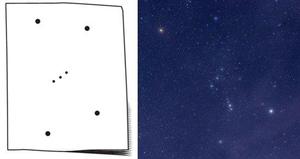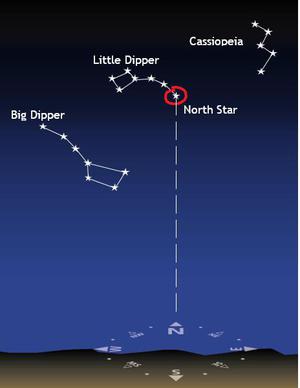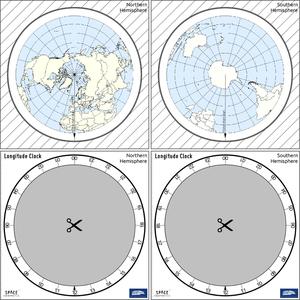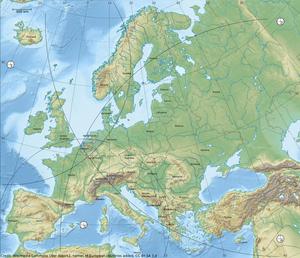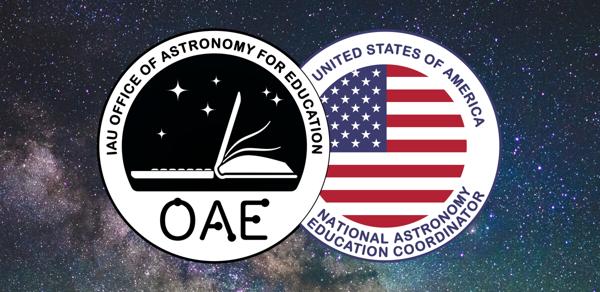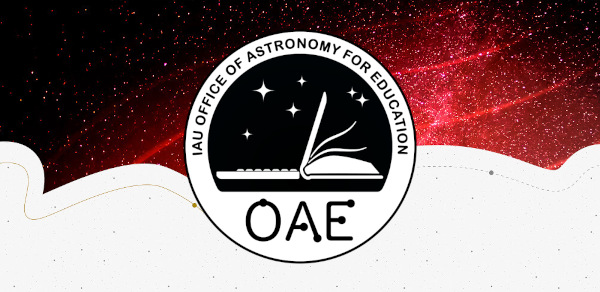Glossary term: Navigation
Description: Navigation is the process of finding out where on Earth or where in space you are, your intended direction of travel, and how to get to where you want to go. Historically, the Sun and stars played an important role in navigation. At the simplest level, in a clear night in the northern hemisphere you can use the North Star to determine where north is and choose your direction of travel accordingly. In the southern hemisphere the Southern Cross points towards south. Prior to the development of modern navigational equipment, "celestial navigation" was essential for navigation. Navigators would determine the angle of the Sun above the horizon at noon to deduce their latitude, and the comparison of the time of local noon (highest sky position of the Sun) with a clock showing Greenwich Mean Time to determine their longitude. Modern navigation mostly relies on signals from GPS and similar satellite systems.
Related Terms:
See this term in other languages
Term and definition status: This term and its definition have been approved by a research astronomer and a teacher
The OAE Multilingual Glossary is a project of the IAU Office of Astronomy for Education (OAE) in collaboration with the IAU Office of Astronomy Outreach (OAO). The terms and definitions were chosen, written and reviewed by a collective effort from the OAE, the OAE Centers and Nodes, the OAE National Astronomy Education Coordinators (NAECs) and other volunteers. You can find a full list of credits here. All glossary terms and their definitions are released under a Creative Commons CC BY-4.0 license and should be credited to "IAU OAE".
Related Media
Sailing the Celestial Seas
Credit: Lucy Yunxi Hu/IAU OAE (CC BY 4.0)
License: CC-BY-4.0 Creative Commons Attribution 4.0 International (CC BY 4.0) icons
Star Trails of the Forbidden City
Credit: Stephanie Ziyi Ye/IAU OAE (CC BY 4.0)
License: CC-BY-4.0 Creative Commons Attribution 4.0 International (CC BY 4.0) icons
Related Activities
What is a Constellation?
astroEDU educational activity (links to astroEDU website) Description: Investigate three dimensional objects and perspective using constellationsLicense: CC-BY-4.0 Creative Commons Attribution 4.0 International (CC BY 4.0) icons
Tags: Hands-on Age Ranges: 6-8 , 8-10 Education Level: Primary Areas of Learning: Modelling , Social Research Costs: Medium Cost Duration: 1 hour 30 mins Group Size: Group Skills: Analysing and interpreting data , Asking questions , Constructing explanations , Developing and using modelsHow To Travel on Earth Without Getting Lost
astroEDU educational activity (links to astroEDU website) Description: Use a globe to describe your position on Earth.License: CC-BY-4.0 Creative Commons Attribution 4.0 International (CC BY 4.0) icons
Tags: Geography , Maps , GPS , Celestial navigation Age Ranges: 8-10 , 10-12 , 12-14 Education Level: Middle School , Primary Areas of Learning: Social Research Costs: Low Cost Duration: 1 hour Group Size: Group Skills: Analysing and interpreting data , Developing and using models , Using mathematics and computational thinkingThe Quest for Longitude
astroEDU educational activity (links to astroEDU website) Description: How to navigate at sea like an explorer?License: CC-BY-4.0 Creative Commons Attribution 4.0 International (CC BY 4.0) icons
Tags: Clocks , Geography , Coordinates , Celestial navigation , James Cook , Exploration Age Ranges: 14-16 , 16-19 Education Level: Middle School , Secondary Areas of Learning: Discussion Groups , Modelling , Social Research Costs: Low Cost Duration: 2 hours Group Size: Group Skills: Analysing and interpreting data , Asking questions , Communicating information , Developing and using models , Planning and carrying out investigations , Using mathematics and computational thinkingWhere on Earth am I?
astroEDU educational activity (links to astroEDU website) Description: How do satellite-based positioning and GPS navigation work?License: CC-BY-4.0 Creative Commons Attribution 4.0 International (CC BY 4.0) icons
Tags: Clocks , Geography , Maps , GPS , Countries , Speed of light , Galileo Age Ranges: 14-16 Education Level: Middle School Areas of Learning: Guided-discovery learning , Problem-solving Costs: Low Cost Duration: 1 hour 30 mins Group Size: Group Skills: Analysing and interpreting data , Asking questions , Communicating information , Constructing explanations , Developing and using models , Using mathematics and computational thinkingNavigate like a Viking – Use the Sun, not your phone!
astroEDU educational activity (links to astroEDU website) Description: Learn how the Vikings used the sky to navigate at sea with a hands-on activity!License: CC-BY-4.0 Creative Commons Attribution 4.0 International (CC BY 4.0) icons
Tags: History , Geography , Maps , Coordinates , Celestial navigation Age Ranges: 12-14 , 14-16 Education Level: Middle School Areas of Learning: Discussion Groups , Modelling , Social Research Costs: Medium Cost Duration: 1 hour 30 mins Group Size: Group Skills: Analysing and interpreting data , Asking questions , Communicating information , Developing and using models , Planning and carrying out investigations , Using mathematics and computational thinking

